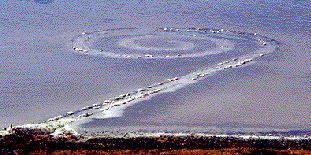
Installation
Art
© Werner Hammerstingl, 1998
Installation art has matured. In the 60's it was in it's infancy as a practice. Marcel Duchamp,Claes Oldenburg, Andy Warhol, Robert Smithson, Joseph Beuys,Christo and others are now well known as pioneers toward this new form of artistic expression.
Many of the now less remembered contributors to the evolution of this medium can be found at least in citation in the excellent 1994 Thames and Hudson publication 'Installation Art'which is written by Nicolas de Oliveira, Nicola Oxley and Michael Petry.
Installation art has it's heritage in the 'gesamtkunstwerk' idea proposed first by the composer Wagner. The concept of the 'gesamtkunstwerk' embodies a sythesis of the various visual art and performance art media on the 'stage'.
The ideas of Wagner resurfaced in the ideologies and works of Futurists, Dadaists, Constructivists and the Bauhaus.
It was however the new experimental, exlorative and anti-establishement culture in the arts that surfaced from the late fifties onwards that resulted in the works that now classicaly fit the installation art mantle.
For a detailed article describing Installation art (by Nicholas Zurbrugg) click here.
A brief History of installation art and events contributing to it's evolution:
Environmental installation case-study
Environmental and earth art installations of monumental scale always tend to bring Christo to the forefront but there are other artists that should also be mentioned.
Robert Smithson for instance became famous for his monumental earthwork "Spiral Jetty" 1969.

Concerning Robert Smithson's work: Lawrence Alloway has defined the relation of site to nonsite in a way which helps us to see this reversibility. The nonsites, he says, constitute "a sculpture of absence": "The site is identified [initially, at the nonsite, in the gallery] by information supplied by the artist in the form of maps, photographs, analogical objects (bins and trays cued by the original lay of the land), rock samples and verbal captions. The nonsite, by this accumulation of references, acts as the signifier of the absent site." And yet, in a dialectical play that Smithson himself surely understood, in the experience of it, the nonsite is itself a site that redefines the original site as the nonsite.
[Henry M. Sayre, The Object of Performance (page 229)]
Large-scale installation case study


Wrapped Reichstag,1995 Christo
After a struggle spanning through the Seventies, Eighties and Nineties, the wrapping of the REICHSTAG was completed on June 24th, 1995 by a work force of 90 professional climbers and 120 installation workers. The Reichstag remained wrapped for 14 days and all materials were recycled.
Paintings in/as installation case study

In the late 1970s Andy Warhol produced some of his most ambitious paintings, often in series. Shadows (1978) is a sequence of 102 large paintings, exhibited side by side on all four walls of a large room, so that all the paintings become a dramatic and colorful environment. The images appear to be completely abstract, but in fact the black silkscreened ink, on variously colored backgrounds, depicts enlarged details of a photograph, probably of the corner of a room. The paintings have a flickering quality, reminiscent of the repeated frames of a film strip. Warhol thought of the room as a discotheque-like space where people could meet, socialize, or dance, as they did at the Studio 54 nightclub which he frequented at the time.
Shadows was first shown in New York in January 1979. It was acquired by Dia Center for the Arts and has been shown only once since, at The Menil Collection in Houston.